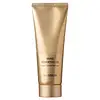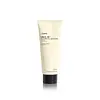What's inside
What's inside
 Key Ingredients
Key Ingredients

 Benefits
Benefits

 Concerns
Concerns

 Ingredients Side-by-side
Ingredients Side-by-side

Water
Skin ConditioningPalmitic Acid
EmollientStearic Acid
CleansingGlycerin
HumectantMyristic Acid
CleansingLauric Acid
CleansingPotassium Hydroxide
BufferingPolyquaternium-39
Sodium Laureth Sulfate
CleansingSorbitan Olivate
EmulsifyingAllantoin
Skin ConditioningPEG-90m
Emulsion StabilisingButylene Glycol
HumectantPropylene Glycol
HumectantSnail Secretion Filtrate
Skin ConditioningPhenyl Trimethicone
Skin ConditioningLecithin
EmollientSodium Hyaluronate
HumectantTriceteareth-4 Phosphate
EmulsifyingVitis Vinifera Seed Oil
EmollientEthylhexylglycerin
Skin ConditioningHydrolyzed Collagen
EmollientCeramide 3
Skin ConditioningDisodium EDTA
Chlorphenesin
AntimicrobialPotassium Sorbate
PreservativePhenoxyethanol
PreservativeParfum
MaskingWater, Palmitic Acid, Stearic Acid, Glycerin, Myristic Acid, Lauric Acid, Potassium Hydroxide, Polyquaternium-39, Sodium Laureth Sulfate, Sorbitan Olivate, Allantoin, PEG-90m, Butylene Glycol, Propylene Glycol, Snail Secretion Filtrate, Phenyl Trimethicone, Lecithin, Sodium Hyaluronate, Triceteareth-4 Phosphate, Vitis Vinifera Seed Oil, Ethylhexylglycerin, Hydrolyzed Collagen, Ceramide 3, Disodium EDTA, Chlorphenesin, Potassium Sorbate, Phenoxyethanol, Parfum
Snail Secretion Filtrate
Skin ConditioningCaprylic/Capric Triglyceride
MaskingGlycerin
HumectantDipropylene Glycol
Humectant1,2-Hexanediol
Skin ConditioningCetearyl Alcohol
EmollientCetearyl Olivate
Sorbitan Olivate
EmulsifyingHydrolyzed Hibiscus Esculentus Extract
Skin ConditioningLupinus Albus Seed Extract
Skin ConditioningMoringa Oleifera Seed Extract
Skin ConditioningSodium Hyaluronate
HumectantWater
Skin ConditioningDimethicone
EmollientSodium Polyacrylate
AbsorbentHydroxyethyl Acrylate/Sodium Acryloyldimethyl Taurate Copolymer
Emulsion StabilisingPalmitic Acid
EmollientTromethamine
BufferingStearic Acid
CleansingEthylhexylglycerin
Skin ConditioningAdenosine
Skin ConditioningAllantoin
Skin ConditioningBetaine
HumectantMyristic Acid
CleansingArachidic Acid
CleansingLauric Acid
CleansingOleic Acid
EmollientTocopherol
AntioxidantCarbomer
Emulsion StabilisingXanthan Gum
EmulsifyingPhenoxyethanol
PreservativeSnail Secretion Filtrate, Caprylic/Capric Triglyceride, Glycerin, Dipropylene Glycol, 1,2-Hexanediol, Cetearyl Alcohol, Cetearyl Olivate, Sorbitan Olivate, Hydrolyzed Hibiscus Esculentus Extract, Lupinus Albus Seed Extract, Moringa Oleifera Seed Extract, Sodium Hyaluronate, Water, Dimethicone, Sodium Polyacrylate, Hydroxyethyl Acrylate/Sodium Acryloyldimethyl Taurate Copolymer, Palmitic Acid, Tromethamine, Stearic Acid, Ethylhexylglycerin, Adenosine, Allantoin, Betaine, Myristic Acid, Arachidic Acid, Lauric Acid, Oleic Acid, Tocopherol, Carbomer, Xanthan Gum, Phenoxyethanol
Ingredients Explained
These ingredients are found in both products.
Ingredients higher up in an ingredient list are typically present in a larger amount.
Allantoin is a soothing ingredient known for its protective and moisturizingg properties. Because of this, it is often added to products with strong active ingredients.
Studies show higher concentrations of this ingredient can promote wound healing.
Though it can be derived from the comfrey plant, allantoin is produced synthetically for cosmetic products to ensure purity.
Learn more about AllantoinEthylhexylglycerin (we can't pronounce this either) is commonly used as a preservative and skin softener. It is derived from glyceryl.
You might see Ethylhexylglycerin often paired with other preservatives such as phenoxyethanol. Ethylhexylglycerin has been found to increase the effectiveness of these other preservatives.
Glycerin is already naturally found in your skin. It helps moisturize and protect your skin.
A study from 2016 found glycerin to be more effective as a humectant than AHAs and hyaluronic acid.
As a humectant, it helps the skin stay hydrated by pulling moisture to your skin. The low molecular weight of glycerin allows it to pull moisture into the deeper layers of your skin.
Hydrated skin improves your skin barrier; Your skin barrier helps protect against irritants and bacteria.
Glycerin has also been found to have antimicrobial and antiviral properties. Due to these properties, glycerin is often used in wound and burn treatments.
In cosmetics, glycerin is usually derived from plants such as soybean or palm. However, it can also be sourced from animals, such as tallow or animal fat.
This ingredient is organic, colorless, odorless, and non-toxic.
Glycerin is the name for this ingredient in American English. British English uses Glycerol/Glycerine.
Learn more about GlycerinLauric Acid is a fatty acid or lipid. About half of fatty acids in coconut oil is lauric acid.
This ingredient helps hydrate and sooth skin. As a humectant, it helps trap moisture. It also aids in cleaning and enhancing the texture of products.
Lauric acid may not be Malassezia folliculitis, or fungal acne, safe.
Learn more about Lauric AcidMyristic Acid is a saturated fatty acid. It is naturally found in milk fat. Other sources include palm oil, coconut oil, and butter fat.
Myristic Acid is an emulsifer and cleanser. As an emulsifer, it stabilizes a product by preventing ingredients from separating. Myristic Acid helps clean your skin by acting as a surfactant. It tends to gather oil and dirt on your skin to be easily rinsed away.
One study from 2021 found Myristic Acid to have anti-inflammatory properties.
Learn more about Myristic AcidPalmitic Acid is a fatty acid naturally found in our skin and in many plant and animal sources. In cosmetics, it is usually derived from palm oil. It serves many purposes in skincare, acting as a cleanser, emollient, and emulsifier.
As an emollient, palmitic acid helps soften and smooth the skin by preventing water loss. In cleansers, it helps remove oil and dirt while creating foam.
Its emulsifying properties help stabilize products by keeping water and oil-based ingredients from separating.
This may not be suitable for fungal acne-prone skin, as fatty acids like this can sometimes trigger breakouts in sensitive individuals.
Learn more about Palmitic AcidPhenoxyethanol is a preservative that has germicide, antimicrobial, and aromatic properties. Studies show that phenoxyethanol can prevent microbial growth. By itself, it has a scent that is similar to that of a rose.
It's often used in formulations along with Caprylyl Glycol to preserve the shelf life of products.
Snail Secretion Filtrate is the excretion from snails. It is an effective moisturizer and promotes collagen production.
A popular nickname for this ingredient is 'Snail Mucin'.
Snail mucin has numerous skin benefits:
On top of this, Snail Secretion Filtrate contains a variety of vitamins and minerals. These include copper peptides, Vitamin A, and vitamin E. Vitamins A and E are antioxidants. Antioxidants help fight free-radicals that damage skin cells.
Being cruelty-free means a brand does not experiment on animals.
If you're worried about the well-being of the snails, we recommend looking more into the company of the product. Many brands have developed humane methods to collect snail mucin.
There is much debate on this subject. On one hand, this ingredient comes from an animal. On the other hand, many will argue the ingredient is naturally secreted (like a natural by-product) and therefore vegan. If you have reservations, you can look into Galactomyces Ferment Filtrate or Centella Asiatica Extract as alternatives.
Learn more about Snail Secretion FiltrateSodium Hyaluronate is hyaluronic acid's salt form. It is commonly derived from the sodium salt of hyaluronic acid.
Like hyaluronic acid, it is great at holding water and acts as a humectant. This makes it a great skin hydrating ingredient.
Sodium Hyaluronate is naturally occurring in our bodies and is mostly found in eye fluid and joints.
These are some other common types of Hyaluronic Acid:
Learn more about Sodium HyaluronateSorbitan Olivate is created from the fatty acids in olive oil and sorbitol.
This ingredient is an oil in water emulsifier. It helps stabilize a product by preventing oils and waters from separating. Sorbitan Olivate also helps hydrate the skin.
Manufacturers sell sorbitan olivate under the name OliveM 1000. OliveM 1000 a multifunctional ingredient. It is self-emulsifying. According to a manufacturer, OliveM 1000 does not disrupt natural skin biome.
Due to its olive oil base, this ingredient may not be fungal-acne safe.
Learn more about Sorbitan OlivateStearic Acid is a fatty acid. It is an emollient, emulsifier, and texture enhancer.
As an emollient, stearic acid helps soften skin. It aids the skin's protective barrier by preventing water loss. It also provides a gentle cleansing effect without stripping away natural oils.
Stearic acid may also be used to enhance the texture of products. It can add volume and stabilize ingredients such as water and oil. This can help water and oil ingredients from separating.
Sources of stearic acid include animal or vegetable fats/oils such as coconut or shea. It can be naturally found in butter, cocoa butter, shea butter, vegetable fats, and animal tallow.
This ingredient may not be Malassezia folliculitis, or fungal-acne safe.
Learn more about Stearic AcidWater. It's the most common cosmetic ingredient of all. You'll usually see it at the top of ingredient lists, meaning that it makes up the largest part of the product.
So why is it so popular? Water most often acts as a solvent - this means that it helps dissolve other ingredients into the formulation.
You'll also recognize water as that liquid we all need to stay alive. If you see this, drink a glass of water. Stay hydrated!
Learn more about Water